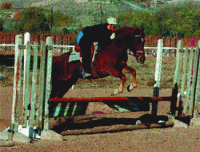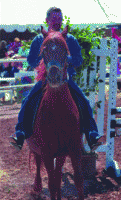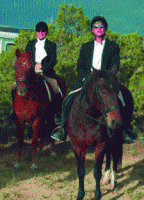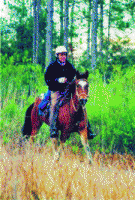The Paso Fino: The Horse with the Fine Step




By Judie Framan
Photos by Elliot Framan
"Often I am asked why Paso Fino’s are so special,” says Fernando De Leon, a New Mexico horse trainer who specializes in gaited horses. “Paso Fino horses are completely different from any other breed for many reasons, but the most important is the smooth ride that is a result of their four beat lateral gait.”
The birthright of every Paso Fino horse is its extremely quick, surefooted rhythmic gait. When my Paso Fino filly, Canela Vita, was born, I watched her struggle to her feet and take her first faltering steps, all the while maintaining her gait. It was as though she recognized her special gift and was executing it with style and pride.
The Mount of the Spanish Conquistadors
Seven hundred years before Columbus brought Paso Fino horses to the new world, the Moors invaded Spain, bringing with them Arabian and Barb (Berber) horses that had a strong impact on equine development throughout Europe and the new world. The conquering horses of the Moors were crossed with the native stock, producing the delicately gaited Spanish Jenett, which had the ability to pass their gait on to its offspring. They were subsequently bred to the Andalusian, a breed that dates back to the Middle Ages. Spanish horses have influenced European breeds from the English Thoroughbred to the Lippizan.
When Columbus landed in America, he found a land devoid of horses. Upon his return to Spain, he gathered horses from the provinces of Cordela and Andalusia, and on his second voyage brought a hand picked group of stallions and mares to the new world. After a difficult voyage, the horses were taken to Santo Domingo, now the Dominican Republic, where they became the foundation stock for the remount stations of the Conquistadors.
Subsequent voyages added more horses, and as the Spanish took more territory, the progeny of the original Paso Fino horses spread throughout the Caribbean. In the early 1500s, horses were taken to Puerto Rico, Cuba, the Isthmus, and Mexico. By the mid-1500s large horse breeding centers were springing up throughout the Caribbean, and soon the breed spread to Mexico, South America, and Panama.
In Puerto Rico, the Paso Fino became a prized possession, and the country’s National Horse. This chance mix of breeds in the isolation of the New World perfected the Paso Fino, and during the 500 years of their existence in the Western Hemisphere, they have performed diverse roles, first in the conquest and later in the development of the Americas. The best traits of the contributing breeds became prominent in the young who enjoyed the hardiness of the Barb and the presence of the Andalusia. The Jenett contributed the treasured smooth even gait, which has became the genetic stamp that identified this horse we call the Paso Fino.
It wasn’t until recently that people began rediscovering the advantages of the comfort, intelligence, power and enthusiasm that is the Paso Fino. Numbering nearly 45,000, the Paso Fino continues to gain popularity in the United States, since they were rediscovered during WWII by American soldiers stationed on the Islands of the Caribbean and in Latin America.
“I own a Paso Fino because I wanted a gaited horse with spirit, courage and a good head,” says Maura Lewiecki of Albuquerque, New Mexico. “I find the Iberian horse quite unique in its sense of self that is exhibited in its carriage, grace and elegance.”
The Magical Paso Fino Gait
“Paso Fino’s have the smoothest gait of all gaited horses,” says De Leon. “It is a lateral gait, which is evenly spaced with each foot striking the ground independently of the others. The hind legs provide the power of the gait, and the weight is distributed evenly from one side to the other, thus the impact of the footfalls is dissipated in such a manner that the ride is incredibly smooth.”
The Paso Fino has the ability to perform the four beat lateral gait at three speeds, the Classic Fino, Paso Corto, and Paso Largo. Varying degrees of speed are used to execute the three speeds, and collection is dependent on the speed.
Classic Fino
This gait is usually reserved for the show ring. The horse is fully collected and the forward
speed is very slow, thus demonstrating the rapid, steady unbroken rhythm of the hooves. One famous Paso Fino stallion, Capuchino, is reported to have 126 beats per minute and a four inch extension. On the fino board, this sounds like rolling thunder.
Paso Corto
While all Paso Fino gaits are pleasurable, most equestrians look to a Paso Fino for its comfortable medium speed gait—the Paso Corto. This gait is the average trail gait and is comparable to a trot. A well conditioned horse can go for hours at this gait, and so can the rider because of the smoothness of the corto.
Paso Largo
The largo, a full extension of the four beat lateral gait, is smooth, balanced and elegant. At the largo, the Paso Fino can cover ground at breathtaking speed while providing a secure seat for the rider. A well trained Paso Fino can reach speeds up to 18 miles per hour at the largo. And, of course, the Paso Fino has a free moving walk and can have a delightful canter. Many people may think the Paso Fino’s are such little horses, but actually they are bred for physical balance and have a muscular structure proportionate to their size. “I’ll take a small horse with a big heart like the Paso Fino any day,” says De Leon in answer to this comment. “These horses are the perfect size to ride. They can travel great distances, and they are easy to mount and dismount.” The breed standard requires that the Paso Fino be between 13 and 15.2 hands with an average being 14.2.
When in top condition, a horse can carry a third of its weight comfortably. This is true because of their conformation. The longer the horses back, the longer its legs, which results in a greater extension in the stride. This means the horse can carry less weight in the center of his back, which makes for a rougher ride. With the Paso Fino, the step is so short that there is not the rocking motion caused by great extension of stride.
Versatility
The Paso Fino is not just a high-energy gaited show horse, they can do it all. The performance show horse can also be a great trail horse. Their compact size and quickness have earned the breed a place on working cow ranches, and they have the grace and elegance to compete in dressage and jumping.
David Williams of Corrales, New Mexico puts it this way. “Our most exciting experience with Paso Fino’s came shortly after we bought our first pair, both of which were retired show horses,” he said. “We took them out to ride in the Corrales Bosque and got them into a fast Paso Corto gait. We zipped along the trail, weaving through the thick vegetation as though we were driving finely tuned sports cars with great suspension, precision handling and lots of power under the saddle. We’ve been hooked ever since.”
Terry Wallace of 2-W Paso Fino’s near Falcon, Colorado, became intrigued with the Paso Fino after years of riding Quarter Horses. “I was interested in a gaited breed of horse as my husband began to suffer from a bad back. Although I have had horses all of my life, I had never heard of a Paso Fino. The smooth gait hooked me right away. But it was the ‘look,’ the Spanish head, large eye, long, thick mane and tail, that really convinced me—a beautiful Spanish bred horse that gaited. We bought two Paso Fino’s eight years ago and now we have 12.
One filly went on to distinguish herself as a show horse, and to my delight, I won my first gaited horse class, open pleasure mares, with her. Paso Fino’s have tremendous stamina and are used for competitive trail and endurance competition, where they often win national honors.
“Paso Fino’s can do as much as any breed in competitive trail and endurance. They excel at this type of riding because of their comfortable gait that is conducive to rider comfort over long distances,” says endurance rider Lindsey Campbell, who owns Vistalargo Farm in Lake City, Florida. “Plus, they have a lot of heart and can cover varied terrain well. Paso’s can keep in their gait on downhill trails without stumbling while trotting horses must slow down. And if they are a true ‘trail’ horse, they have wonderful dispositions and are people friendly.”
Campbell’s gelding, Obrizo Juan Sinsonte, which she co-owns with her friend Joe Edward Casillas, was Paso Fino Endurance Horse of the Year for 2004. His sire, Leo de Vez, was reserve Endurance Horse of the Year. Campbell says that most Paso’s that are competing in endurance and competitive trail rides are entering the shorter rides of 25-35 miles and a few are doing the 50 mile endurance rides such as the world famous Tevis Cup.
Healthcare professionals including orthopedists and chiropractors are recommending Paso Fino’s to their patients with back and neck injuries who, like me, refuse to give up riding for anything in the world. Albuquerque horsewoman Beverly Fitzsimons says, “Six years after my MS diagnosis, I am riding again and experiencing more flexibility in my movement, and a sense of empowerment and freedom the disease took from me. Through the Paso Fino’s easy, fluid gait, I can again experience movement without impairment, and enjoy the pleasures of ‘walking’ in the Bosque.”
As for me, with my stiff joints and arthritis, it is a pleasure to know that I can ride my Paso Fino horses and enjoy a smooth, no-bounce trail ride that doesn’t wear me out at the end of the day.
About the Author
Judie Framan was a writer, lifelong horsewoman, biologist and nature enthusiast. A noted international equestrian travel journalist, she married her love of horses, nature and travel in the horseback riding adventures she took around the around the world. Judie passed away in 2011 and the horse world will miss this passionate equestrian traveler and journalist.




